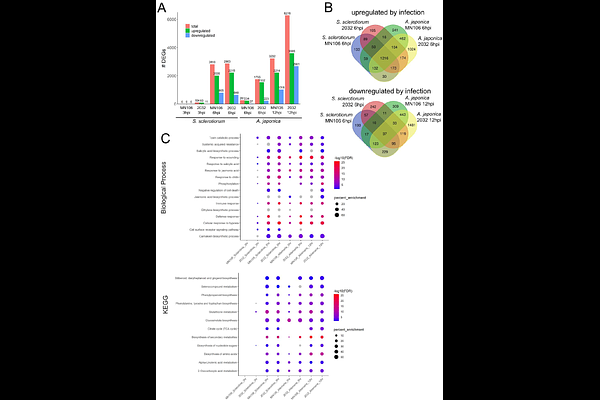Fungal susceptibility and early flowering in pennycress (Thlaspi arvense) are conferred by naturally occurring mutations in histone demethylase Jumonji 14

Fungal susceptibility and early flowering in pennycress (Thlaspi arvense) are conferred by naturally occurring mutations in histone demethylase Jumonji 14
Codjoe, J. M.; Kujur, A.; Sirasani, J. P.; Shamin, A.; Sauer, T.; Rai, K.; Ulmasov, T.; Chopra, R.; Shah, D. M.
AbstractPennycress (Thlaspi arvense) is a winter oilseed domesticated recently to be incorporated as an intermediate crop between the existing cropping systems of the US Midwest. We show that a natural accession of pennycress, 2032, is more susceptible to the necrotrophic fungal pathogens Sclerotinia sclerotiorum and Alternaria japonica than the reference pennycress accession MN106. A previously identified marker associated with early flowering and maturity in pennycress was found to be present in a gene homologous to Arabidopsis Jumonji 14 (JMJ14). It has been reported that AtJMJ14 promotes disease resistance and represses flowering, and greenhouse studies of breeding populations confirmed this phenomenon in pennycress. Plants with the 2032 TaJMJ14 allele were more susceptible to fungi and flowered early. CRISPR-Cas9 editing was used to generate additional TaJMJ14 alleles. A 9-base pair deletion in the 6th exon of TaJMJ14 showed trends of early flowering and S. sclerotiorum susceptibility, whereas a complete loss-of-function allele led to infertility. We further investigated the transcriptomes of MN106 and 2032 plants in the early stages of S. sclerotiorum and A. japonica infection to identify potential resistance and susceptibility genes. Differences in the expression of pathogen-associated molecular pattern-triggered immunity (PTI)-associated genes led us to discover that 2032 plants have defects in elicitor-triggered oxidative bursts. The transcriptional responses unique to each accession lay a foundation for future gene-editing and breeding approaches to keep the beneficial early flowering phenotype conferred by 2032 but uncouple it from disease susceptibility.